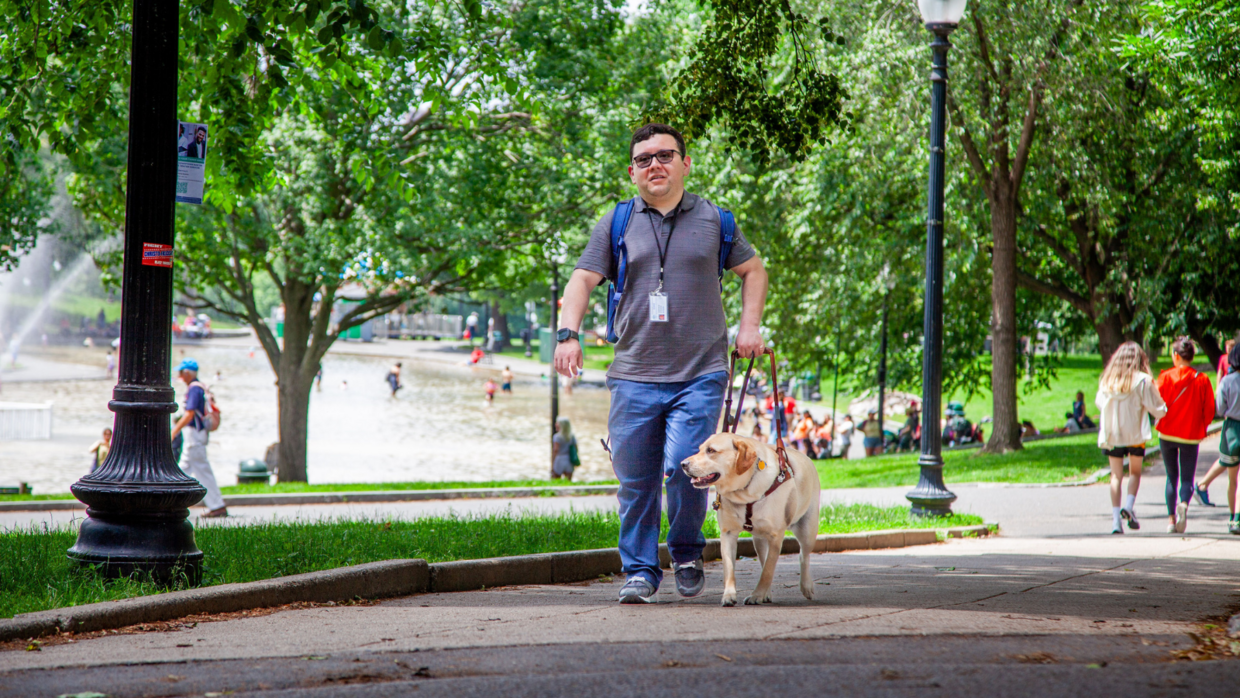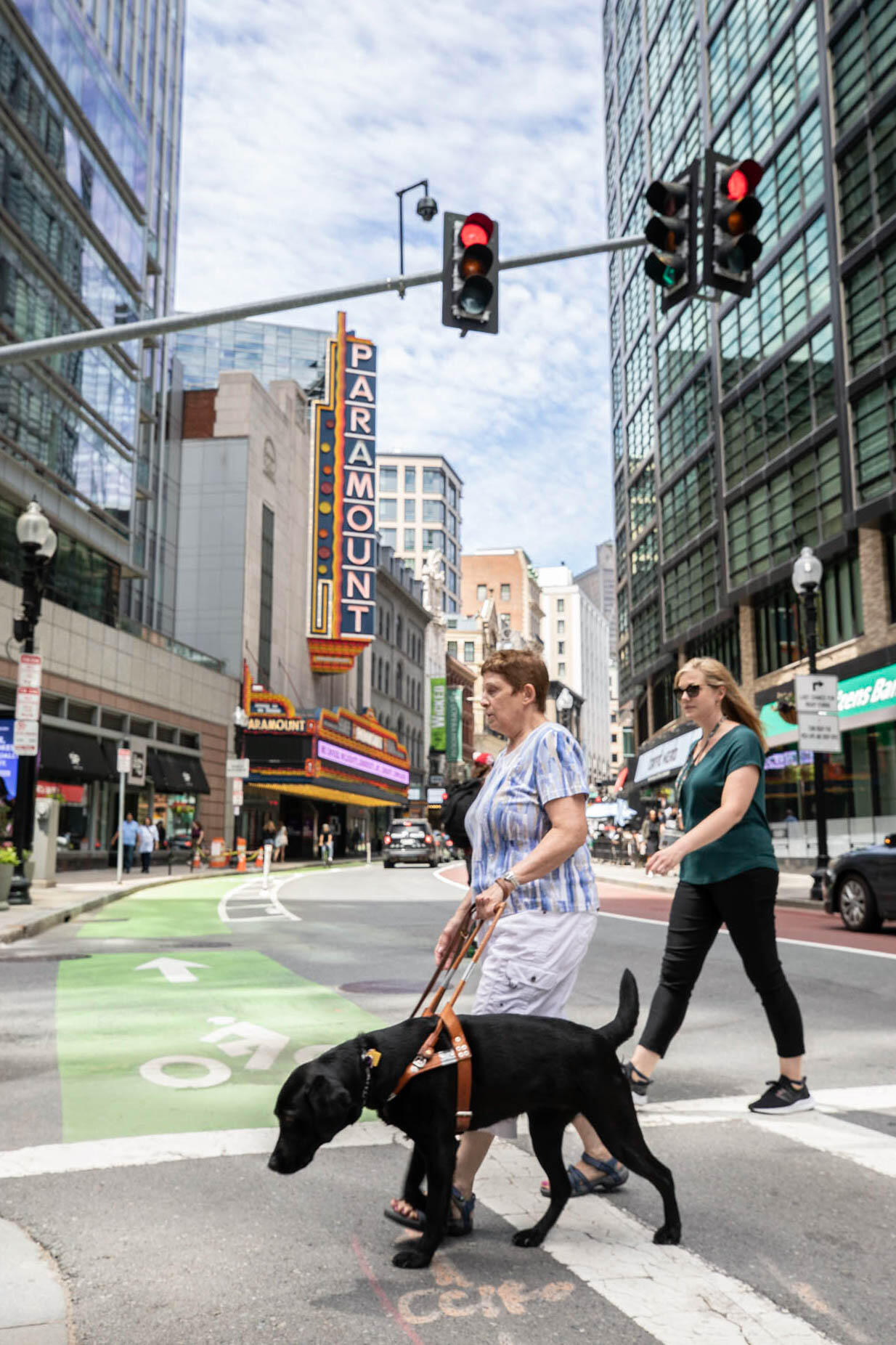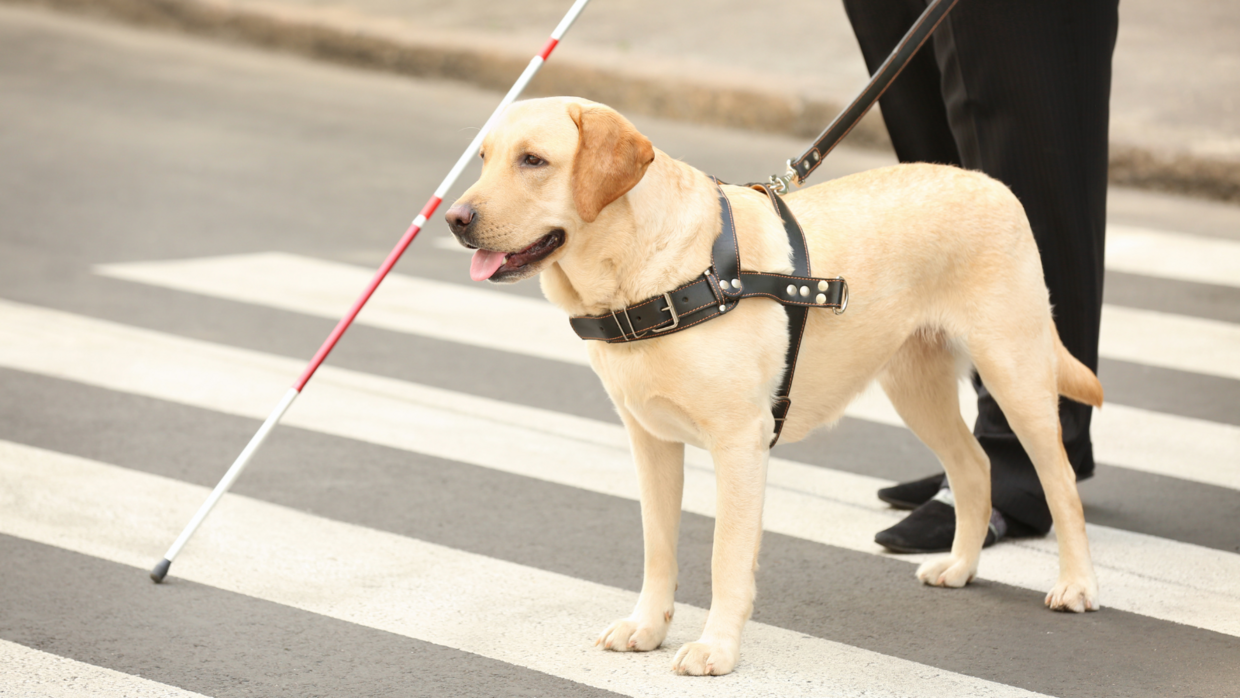Harnessing Your Potential: An Introduction to Guide Dog Travel
Video: Harnessing Your Potential: An Introduction to Guide Dog Travel
Skip this video Harnessing Your Potential: An Introduction to Guide Dog Travel.Thank you to everyone who joined our Harnessing Your Potential: An Introduction to Guide Dog Travel webinar on April 25! We explored how the Massachusetts Commission for the Blind helps individuals who are legally blind build the independent travel skills needed to succeed as guide dog handlers. Participants heard firsthand stories from guide dog users Lisa Judelson and Lina Coral, gained insights from Guide Dogs for the Blind, and learned about service dog rights from the Massachusetts Office on Disability.
Missed the webinar or want to revisit the conversation?
Massachusetts Commission for the Blind’s Role in Connecting Consumers with Guide Dog Resources
The Massachusetts Commission for the Blind does not provide guide dogs, but our counselors can assist legally blind residents who are interested in connecting with the appropriate resources.
Guide dogs are not suitable for everyone. Potential guide dog handlers must complete necessary Orientation and Mobility (O&M) training before applying. We offer this service to Massachusetts residents who are legally blind.
Most guide dog schools cover the costs of attending the school and training with a guide dog, including transportation to and from the school. Guide dog training typically takes place at the school.
Guide dog owners are responsible for the independent care of their guide dog, including the costs of food and veterinary visits.
Most guide dog schools breed their own dogs. Puppies are evaluated for suitability for guide dog training at six to eight weeks old. If selected, they are placed with volunteer "puppy raisers" who provide a family environment and teach basic obedience and socialization skills. After approximately a year, the dogs return to the school for several months of intensive guide dog training before being paired with a person.
Once paired with a guide dog, our Certified Orientation and Mobility Specialists are available to provide route orientation, helping the handler feel comfortable and confident in using their dog guide.
Important Note: Each guide dog school has its own admission criteria, expectations, training programs, and timelines. The information provided here is intended as an overview for informational purposes only. For specific details regarding application procedures, training, and other requirements, we recommend contacting the guide dog schools directly.
Hadley Guide Dog Resources: Considerations, Responsibilities, and Misconceptions
Explore key insights into owning a guide dog through concise resources from Hadley. Learn about the responsibilities of guide dog ownership, common misconceptions, and basic questions to determine if a guide dog is right for you. These resources provide valuable information to guide your decision-making process. For large print, digital talking book audio, or braille versions of these resources, contact Hadley directly.
Is a Guide Dog Right for You?
Basic questions to consider before pursuing a guide dog.
Common Misconceptions About Guide Dogs
Debunk common myths that could impact your decision-making process.
Responsibilities of Guide Dog Ownership
Understand the daily care, commitment, and potential challenges of having a guide dog.
Guide Dog & Assistance Dog Schools
Assistance dogs and guide dogs are both highly trained service dogs that help people with disabilities, but there are key differences in their roles and training.
Guide dogs are specifically trained to assist individuals with vision loss. They help their handler navigate obstacles, cross streets, and find specific locations, such as doors or elevators, in various environments. On the other hand, assistance dogs are trained to help individuals with a wide range of disabilities, not just visual impairments. These dogs can assist people with physical disabilities, mobility impairments, hearing impairments, or other medical conditions. Depending on the specific needs of their handler, assistance dogs can perform tasks such as retrieving items, opening doors, alerting to medical conditions like seizures, or providing physical support. While all guide dogs are assistance dogs, not all assistance dogs are guide dogs, as the key difference lies in the specific tasks they are trained to address.
Guide Dog Schools
California
Connecticut
Florida
Kansas
Michigan
New Jersey
New York
Ohio
Texas
Assistance Dog Schools
Assistance Dog Resources
Legal Rights and Obligations: Guide Dogs and Other Assistance Animals
Understanding the legal rights and obligations related to guide dogs and other assistance animals is essential for both individuals with disabilities and those who interact with them. Federal and state laws provide protections and define the responsibilities of service animal handlers and the general public.
The Massachusetts Office on Disability (MOD) provides information, guidance, and training on disability-related civil rights and architectural access. MOD helps individuals understand their rights and obligations, how regulations apply to their specific situations, and practical steps they can take to assert their rights or comply with the law.
Massachusetts Laws Relevant to Guide Dogs
- Protection of blind pedestrians crossing or attempting to cross ways
- Physically handicapped persons with dog guides; public places or conveyances; charges or fares; penalties
Support and Resources from the Massachusetts Office on Disability (MOD)
Disability Rights for Users of Assistance Animals
- MOD can help individuals understand the rights and responsibilities associated with service animals and emotional support animals in different settings.
Assistance Animals in Housing
- MOD provides information about the laws that apply to assistance animals in housing and tips to help an assistance animal handlers and a housing provider navigate the reasonable accommodation process.
Consultation
- If you have questions about disability rights laws or physical accessibility regulations that have not been answered by reading MOD's website, you can request a phone or email consultation.
Video: Massachusetts Office on Disability: Service Animals in Public Settings
Skip this video Massachusetts Office on Disability: Service Animals in Public Settings.Video: Massachuestts Office on Disability: Service and Emotional Support Animals in the Workplace
Skip this video Massachuestts Office on Disability: Service and Emotional Support Animals in the Workplace.Federal Resources: U.S. Department of Justice Civil Rights Division
Service Animals Overview
- Learn how the Americans with Disabilities Act (ADA) defines service animals, where they are allowed, and the rights and responsibilities of individuals using service animals in public spaces.
ADA Requirements for Service Animals
- This guide outlines the specific ADA rules about service animals, including where they are allowed, what questions can be asked by businesses, and how service animals must behave in public spaces.
History of Guide Dogs
The earliest known depiction of the special bond between an individual who is blind and a dog can be traced to a first-century AD mural discovered in ancient Rome.
The modern guide dog movement, however, has its roots in the aftermath of World War I, when thousands of soldiers returned home with blindness. Dr. Gerhard Stalling, a German physician, conceived the idea of training dogs to assist these veterans after observing his dog looking after a blind patient at a hospital. Inspired by this, Dr. Stalling began exploring systematic methods to train dogs as reliable guides.
In 1916, Dr. Stalling founded the world’s first guide dog school, which rapidly expanded, training up to 600 dogs annually. These dogs were provided not only to veterans but also to individuals who are blind worldwide, including in the United States. However, due to a decline in the quality of the dogs, the school closed in 1926. By then, a new guide dog training center near Berlin had gained recognition for producing up to 12 fully trained guide dogs each month.
Around this time, Dorothy Harrison Eustis, an American woman, was already training dogs for the military and police in Switzerland. Eustis became a key figure in expanding the guide dog movement internationally. In 1927, she wrote an article for The Saturday Evening Post, which was read by Morris Frank, a man who was blind.
Frank was so moved by the article that he later remarked the five cents he spent on the newspaper "bought an article worth more than a million dollars to me. It changed my life." He reached out to Eustis with the hope of introducing guide dogs to the United States. In response, Eustis trained a dog named Buddy and brought Frank to Switzerland to learn how to work with his new guide dog. Frank returned to the United States with what is believed to be the first guide dog in America. In 1929, Eustis established The Seeing Eye School in New Jersey, a pioneering institution in the field.
Since then, guide dog schools have been established worldwide, and thousands of individuals lives have been transformed by guide dogs, thanks to the dedication of the organizations that provide them. The legacy of guide dog training continues to flourish globally.
Myths vs. Facts
Curious about common misconceptions surrounding guide dogs? This quick fact sheet clears up misunderstandings about guide dog training, behavior, and role in supporting individuals with vision loss.
Share Your Guide Dog Story: Inspire and Educate Others
At the Massachusetts Commission for the Blind, we’re working to change how blindness is perceived. Through personal stories, images, and videos, we highlight the independence, achievements, and everyday lives of individuals who are legally blind.
By sharing your experience with a guide dog, you can help raise awareness about how these dogs support individuals with vision loss in leading more independent lives. Your story will also contribute to building a stronger, more connected blindness community, showing how we support and uplift each other.
Help us change perceptions and emphasize the capabilities of the blindness community. Your story can make a meaningful impact.



